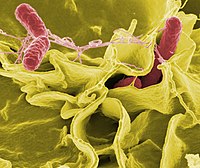
Photo from wikipedia
Salmonella remains one of the most common foodborne pathogens worldwide, and its resistance to antimicrobials has increased considerably over the years. In this context, was evaluated the action of three… Click to show full abstract
Salmonella remains one of the most common foodborne pathogens worldwide, and its resistance to antimicrobials has increased considerably over the years. In this context, was evaluated the action of three bacteriophages isolated or combined in inhibiting the adhesion and removal of Salmonella Heidelberg biofilm on a polystyrene surface. The bacteriophages UPF_BP1, UPF_BP2, UPF_BP3 and a pool of them were used for biocontrol of Salmonella Heidelberg biofilms on polystyrene surface in the action times of 3, 6 and 9 h. Individual and combined phages exhibited reductions in Salmonella Heidelberg adhesion of up to 83.4% and up to 64.0% in removal of preformed biofilm. The use of synergistic combinations between the phages is the most indicated option due to its potential to reduce biofilms. The use of the bacteriophage pool in surface conditioning is an alternative in the control of Salmonella Heidelberg biofilms.
Journal Title: Food Science and Technology International
Year Published: 2022
Link to full text (if available)
Share on Social Media: Sign Up to like & get
recommendations!